Valley of the Kings EarthCache
-
Difficulty:
-

-
Terrain:
-

Size:  (not chosen)
(not chosen)
Related Web Page
Please note Use of geocaching.com services is subject to the terms and conditions
in our disclaimer.

![[CNW:Counter]](https://imgproxy.geocaching.com/02c74cf1e6ba17fb07e70e270cf6afa18570c904?url=http%3A%2F%2Fcounter.cnw.cz%2Fdiablo.cgi%3FEARTH_Udoli_kral%265%26ff6600%26ccffff%26on) The Valley of the Kings (Arabic : Wadi Biban el-Muluk; "Gates of the
King")
The Valley of the Kings (Arabic : Wadi Biban el-Muluk; "Gates of the
King")

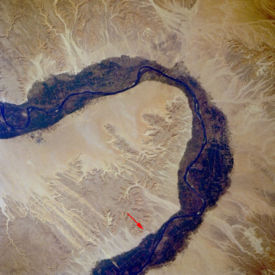
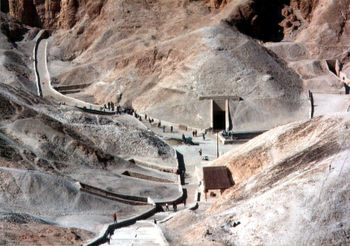


The valley in Egypt where for a period of nearly 500 years from the
16th to 11th century BC , tombs were constructed for the kings and
powerful nobles of the New Kingdom (the Eighteenth through
Twentieth Dynasties of Ancient Egypt ). The valley stands on the
west bank of the Nile , across from Thebes (modern Luxor ), within
the heart of the Theban Necropolis . The wadi consists of two
valleys, East Valley (where the majority of the royal tombs
situated) and West Valley. The area has been a focus of
concentrated archaeological and egyptological exploration since the
end of the eighteenth century , and its tombs and burials continue
to stimulate research and interest. In modern times the valley has
become famous for the discovery of the tomb of Tutankhamun (with
its rumours of the Curse of the Pharaohs ), and is one of the most
famous archaeological sites in the world. In 1979, it became a
World Heritage Site , along with the rest of the Theban
Necropolis.
Geology
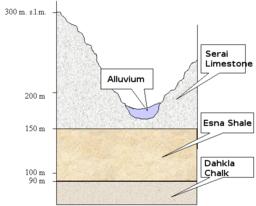 During the Pleistocene the
valley was carved out the plateau by steady rains. There is
currently little year-round rain in this part of Egypt, but
there are occasional flash floods which hit the valley,
dumping tons of debris into the open tombs. The quality of the
rock in the Valley is inconsistent, ranging from
finely-grained to coarse stone, the latter with the potential
to be structurally unsound. The occasional layer of shale also
caused construction and conservation difficulties, as this
rock expands in the presence of water, forcing apart the stone
surrounding it. It is thought that some tombs were altered in
shape and size depending on the types of the layers of rock
the builders encountered
During the Pleistocene the
valley was carved out the plateau by steady rains. There is
currently little year-round rain in this part of Egypt, but
there are occasional flash floods which hit the valley,
dumping tons of debris into the open tombs. The quality of the
rock in the Valley is inconsistent, ranging from
finely-grained to coarse stone, the latter with the potential
to be structurally unsound. The occasional layer of shale also
caused construction and conservation difficulties, as this
rock expands in the presence of water, forcing apart the stone
surrounding it. It is thought that some tombs were altered in
shape and size depending on the types of the layers of rock
the builders encountered
History
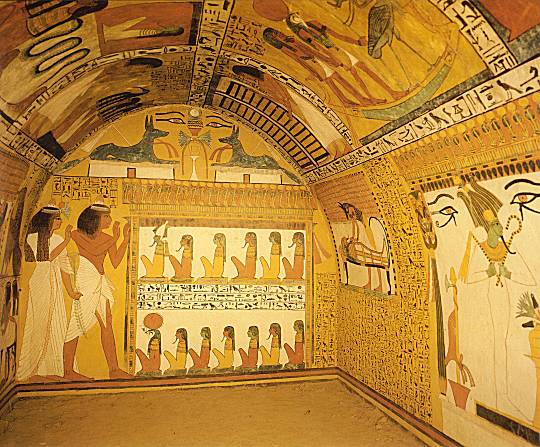 The Theban Hills are dominated by
the peak of al-Qurn , known to the Ancient Egyptians as ta
dehent, or 'The Peak'. It has a pyramid shaped appearance, and
it is probable that this echoed the pyramids of the Old
Kingdom , more than a thousand years prior to the first royal
burials carved here. Its isolated position also resulted in
reduced access, and special tomb police (the Medjay ) were
able to guard the necropolis. While the iconic pyramid
complexes of the Giza plateau have come to symbolize ancient
Egypt, the majority of tombs were in fact cut into rock. Most
pyramids and mastabas contain sections which are cut into
ground level, and there are full rock-cut tombs in Egypt that
date back to the Old Kingdom.
The Theban Hills are dominated by
the peak of al-Qurn , known to the Ancient Egyptians as ta
dehent, or 'The Peak'. It has a pyramid shaped appearance, and
it is probable that this echoed the pyramids of the Old
Kingdom , more than a thousand years prior to the first royal
burials carved here. Its isolated position also resulted in
reduced access, and special tomb police (the Medjay ) were
able to guard the necropolis. While the iconic pyramid
complexes of the Giza plateau have come to symbolize ancient
Egypt, the majority of tombs were in fact cut into rock. Most
pyramids and mastabas contain sections which are cut into
ground level, and there are full rock-cut tombs in Egypt that
date back to the Old Kingdom.
1. The types of soil?
2. What is the name of discoverer Tutankhamun tombs?
3. What dynasti here bury?
4. On what side Nil valley lies?
Then please attach your photo in the place Valley of the Kings in
accordance with attached spoiler and the photo any tombs with her
coordinates. Email your answers to: geo.marzcz@seznam.cz , subject:
„Earth-Valley of the Kings “.
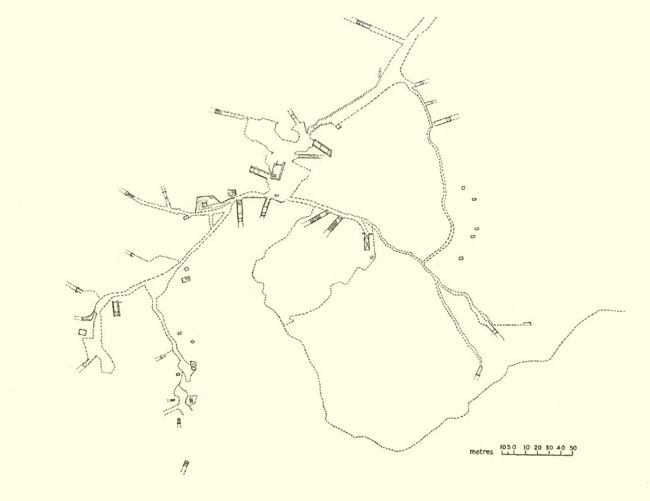
 >
>






Additional Hints
(Decrypt)
Hfr fcbvyre